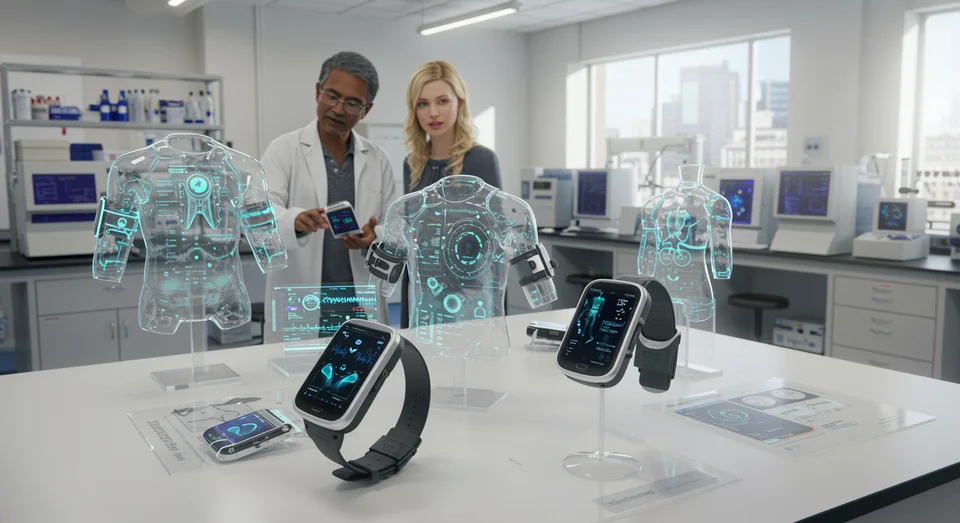Northwestern University Unveils Contactless Wearable Revolutionizing Health Monitoring and Wound Care
56 views
A Breath of Innovation: Contactless Wearable Redefines Health Monitoring
In a world where technology increasingly intertwines with healthcare, researchers at Northwestern University have unveiled a groundbreaking innovation that could reshape how we understand and manage our health. This pioneering device—a contactless wearable capable of analyzing gases emitted and absorbed by the skin—has the potential to redefine non-invasive medical care, offering a lifeline for individuals with fragile or damaged tissue.
Unlike conventional wearables that require direct contact with the skin, this sensor-laden marvel hovers just above its surface, creating an entirely new category of health monitoring. Its ability to measure gases such as carbon dioxide (CO2) and volatile organic compounds (VOCs) in real time provides a window into the body’s complex chemistry. From tracking hydration levels to aiding wound healing and detecting infections, the device’s applications promise to be as diverse as they are transformative.

The implications for clinical care are profound. For patients recovering from burns, undergoing skin grafts, or battling chronic wounds, traditional wearable devices can often exacerbate their conditions due to the pressure or irritation they cause. By eliminating the need for physical contact, this new technology offers a gentler alternative, one that is not only more comfortable but also more efficient. Synchronizing seamlessly with smartphones or tablets, it empowers patients to monitor their skin health from the comfort of their homes. This, in turn, enables healthcare providers to make faster, more informed decisions—a critical advantage in preventing complications or accelerating recovery.
But the potential applications extend far beyond wound care and hydration monitoring. The device’s enhanced gas sensors could be a game-changer in detecting early signs of organ dysfunction or diseases. For instance, certain VOCs are known biomarkers for conditions like liver disease or diabetes. By identifying these gases at an early stage, the wearable could serve as a non-invasive diagnostic tool, alerting users and their physicians to potential health issues before they escalate.
Interestingly, the device also opens doors to less obvious but equally impactful uses. In the realm of skincare, it could evaluate the effectiveness of cosmetic products or even improve the efficacy of bug repellents by analyzing how the skin interacts with various chemicals. These seemingly niche applications hint at a broader trend: the merging of technology and personal care in ways that prioritize both safety and efficacy.
Yet, as with any nascent technology, challenges remain. The researchers are already looking ahead, aiming to refine the device by incorporating pH monitoring and enhancing its chemical selectivity. These advancements could further personalize health tracking, tailoring it to the unique physiological needs of each user. Imagine a future where a single wearable not only tracks hydration and wound healing but also detects shifts in skin pH that signal impending infections or imbalances. Such a device would not merely monitor health; it would anticipate and prevent illness, embodying the very essence of proactive care.
The broader implications of this innovation extend to the healthcare system as a whole. By enabling at-home monitoring, the device could reduce the frequency of hospital visits, easing the burden on overtaxed medical facilities. This is particularly significant in the context of aging populations and the rising prevalence of chronic diseases, which are straining healthcare resources worldwide. Moreover, the data collected by these wearables could contribute to larger datasets, advancing medical research and enabling more precise, data-driven treatments.
But perhaps the most exciting aspect of this development lies in its accessibility. Unlike many high-tech medical devices that remain confined to hospital settings or specialized clinics, this wearable is designed for everyday use. Its smartphone compatibility ensures that users can interact with it intuitively, without the need for specialized training or equipment. This democratization of healthcare technology could make advanced monitoring tools available to a broader audience, including those in underserved or remote areas.
As we stand on the cusp of this new era in health monitoring, it’s worth reflecting on the broader societal shifts it represents. The rise of wearable technology has long been heralded as a step toward more personalized, patient-centered care. Yet, this device goes a step further, combining the precision of clinical diagnostics with the convenience of consumer technology. It’s not just a tool for monitoring health; it’s a testament to how innovation can bridge the gap between medical science and everyday life.
In the years to come, as researchers continue to refine and expand the capabilities of this contactless wearable, its impact could ripple across industries, from healthcare to cosmetics to environmental safety. For now, it stands as a beacon of what’s possible when cutting-edge science meets human ingenuity—a small device with the potential to make a monumental difference.